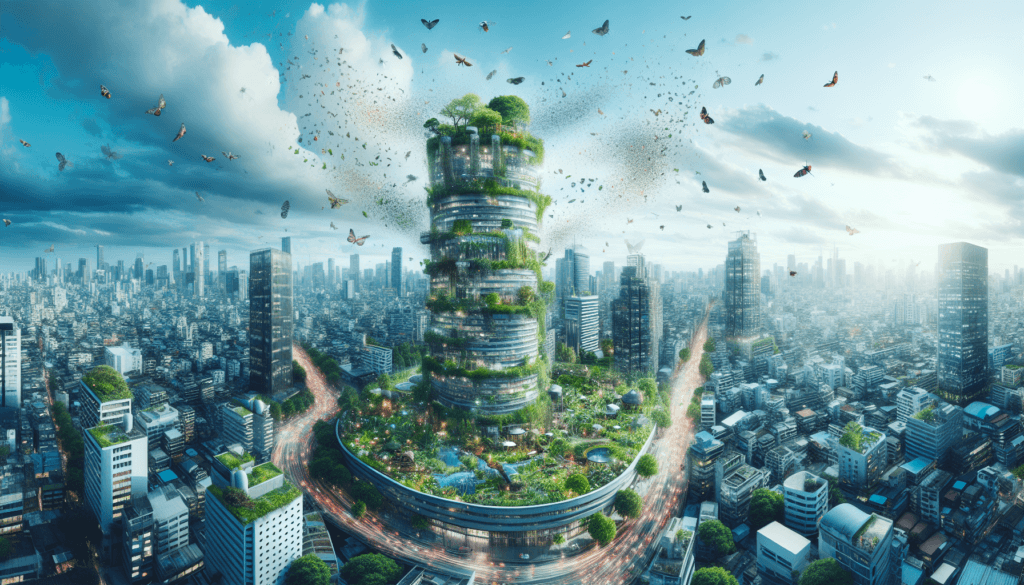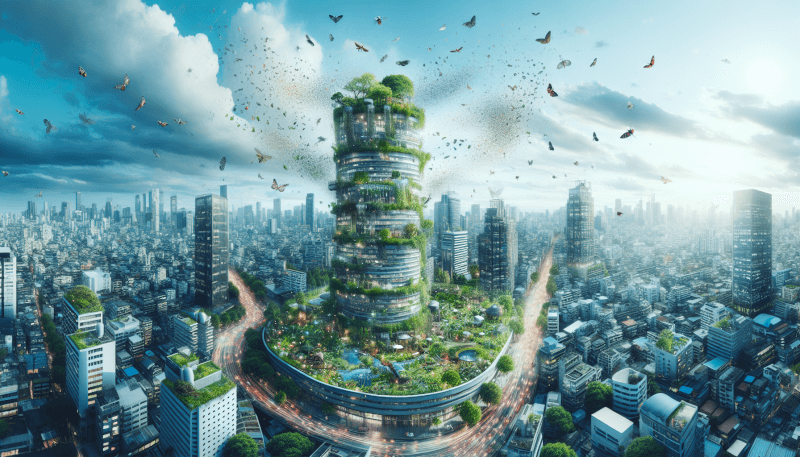Imagine walking through the bustling streets of a modern city, surrounded by concrete and towering skyscrapers. It may seem like the last place you would expect to find vibrant and diverse ecosystems, but urban gardening is changing that perception. In this article, we will delve into the fascinating connection between urban gardening and biodiversity. You will discover how even the smallest green spaces can nurture a stunning array of plant and animal species, bringing nature back into our urban landscapes. So grab your gardening gloves and join us on this exploration of the green oasis amidst the urban jungle.

The Importance of Urban Gardening
Urban gardening is not just a hobby or a way to beautify our cities; it is also a powerful tool for promoting biodiversity in urban areas. By creating green spaces in our concrete jungles, we can increase habitat availability for wildlife and complement natural ecosystems. Urban gardening serves as a vital link between urbanization and environmental conservation, helping to create a harmonious balance between human development and the preservation of nature.
Promoting Biodiversity in Urban Areas
When we think of biodiversity, we often picture lush forests and pristine landscapes. However, urban areas also play a crucial role in supporting and sustaining biodiversity. Urban gardening can act as a catalyst for promoting biodiversity in these spaces. By incorporating a diverse range of plant species and creating suitable habitats, we can encourage the thriving of different organisms, both flora and fauna. Urban gardens become important green oases, offering a refuge for many species that have been displaced due to urbanization.
Increasing Habitat Availability for Wildlife
As our cities continue to expand, the natural habitats of wildlife are shrinking at an alarming rate. Urban gardening provides a vital resource by increasing habitat availability for wildlife. Through strategic planning and design, we can create gardens that cater to the needs of various species, providing them with food, shelter, and breeding grounds. By transforming our urban landscapes into mini-ecosystems, we are offering a lifeline to countless creatures, allowing them to coexist alongside us in our cities.
Complementing Natural Ecosystems
While urban gardening might seem disconnected from natural ecosystems, it can actually play a complementary role. By carefully selecting plant species that are native or adapted to the local environment, we can encourage the proliferation of native pollinators, insects, and birds. These creatures not only enhance the beauty of our gardens but also contribute to the health and resilience of natural ecosystems. Urban gardens act as stepping stones, connecting fragmented landscapes and providing corridors for wildlife movement.
Factors Influencing Biodiversity in Urban Gardens
Several factors influence the biodiversity found in urban gardens. Understanding these factors is essential for creating thriving and resilient ecosystems within our cities.
Size and Design of Gardens
The size and design of urban gardens have a significant impact on the biodiversity they can support. Larger gardens are often better suited for supporting a wider range of species, as they provide more space for diverse habitats. However, even smaller gardens can be optimized for biodiversity by incorporating vertical gardening, hanging baskets, and rooftop gardens. The design of a garden also plays a crucial role in creating suitable habitats for various organisms. Incorporating features such as ponds, bird feeders, and nest boxes can attract different wildlife species and promote biodiversity.
Plant Selection and Diversity
The choice of plants in an urban garden greatly influences its biodiversity. By selecting a variety of plant species with different flowering periods, we can provide a continuous source of food for pollinators and other beneficial insects throughout the year. Native plant species are particularly beneficial, as they have evolved alongside local wildlife and are well-adapted to the local climate and soil conditions. This promotes a healthy ecosystem where native species can thrive and reproduce.
Maintenance Practices
The way we care for our urban gardens can also impact biodiversity. Using organic gardening methods and avoiding the use of chemical pesticides and fertilizers helps to maintain a healthy balance between pests and beneficial insects. Regular pruning and cleaning of gardens can also prevent the buildup of debris and provide a cleaner and safer environment for wildlife. By adopting sustainable maintenance practices, we can create a thriving ecosystem that supports a wide range of species.
Benefits of Urban Gardening for Biodiversity
Urban gardening offers numerous benefits for biodiversity, creating a win-win situation for both humans and the natural world.
Providing Food and Shelter for Wildlife
Urban gardens act as important sources of food and shelter for wildlife, especially in areas where natural habitat is scarce. By incorporating plants that provide nectar, fruits, and seeds, we can attract a diverse range of birds, butterflies, bees, and other pollinators. Additionally, features like birdhouses, nesting boxes, and insect hotels offer safe havens and nesting sites for wildlife. Providing these resources within our cities helps mitigate the loss of natural habitats and ensures the survival of many species.
Promoting Pollinators and Beneficial Insects
One of the most significant contributions urban gardens make to biodiversity is the promotion of pollinators and beneficial insects. Bees, butterflies, and other pollinators are essential for the reproduction of plants and the maintenance of healthy ecosystems. By planting a variety of flowering plants and providing suitable habitats, we can attract and support these vital pollinators. Beneficial insects, such as ladybugs and lacewings, help control pests naturally, reducing the need for harmful chemical pesticides.
Contributing to Local Ecological Networks
Urban gardens act as important nodes in local ecological networks, connecting various habitats and facilitating the movement of wildlife. When urban gardens are strategically planned and designed, they provide corridors for species to travel between larger natural areas, sustaining gene flow and promoting genetic diversity. By actively participating in urban gardening and creating these connections, we contribute to the resilience of local ecosystems and ensure the survival of many species.
Challenges and Solutions for Biodiversity in Urban Gardens
While urban gardening holds great potential for promoting biodiversity, it also faces several challenges. Recognizing and addressing these challenges is essential for creating thriving and sustainable ecosystems within our cities.
Limited Space and Resources
One of the primary challenges of urban gardening is the limited space available. With land at a premium in urban areas, finding suitable areas for gardening can be a significant hurdle. However, innovative solutions like community gardens, rooftop gardens, and vertical gardening techniques can help maximize the use of limited space. Collaborative efforts between local authorities, community organizations, and residents can create more opportunities for urban gardening and increase the amount of green space available.
Dealing with Invasive Species
Another challenge in urban gardening is the presence of invasive species. Invasive plants and animals can outcompete native species, disrupt ecosystems, and reduce biodiversity. However, proper plant selection, regular monitoring, and early intervention can help prevent the spread of invasive species. Education and awareness campaigns can also inform gardeners about the importance of avoiding and managing invasive species, ensuring the long-term health and sustainability of urban gardens.
Managing Pest Control Sustainably
Pest control is a common concern in gardens, and it often involves the use of chemical pesticides. However, reliance on these chemicals can harm beneficial insects, disrupt ecosystems, and pose a risk to human health. Adopting sustainable pest control practices, such as integrated pest management (IPM), helps minimize the use of harmful pesticides. IPM focuses on preventive measures, biological controls, and targeted treatments, ensuring a healthier and more biodiverse garden environment.

Community Engagement and Education
Community engagement and education play a crucial role in creating and maintaining biodiverse urban gardens. By involving the community, we can foster environmental awareness, build social connections, and encourage sustainable gardening practices.
Promoting Environmental Awareness
Urban gardening provides an excellent platform for promoting environmental awareness and education. Through workshops, seminars, and community events, we can educate residents about the importance of biodiversity and the role they can play in preserving it. By raising awareness about the benefits of urban gardening and its positive impact on biodiversity, we can inspire more individuals to get involved and make a difference.
Building Social Connections
Community engagement in urban gardening goes beyond mere gardening activities. It fosters social connections and a sense of belonging among residents. Community gardens serve as communal spaces where neighbors can work together, share experiences, and learn from one another. These interactions strengthen social bonds and create a sense of unity, making communities more resilient and supportive.
Encouraging Sustainable Gardening Practices
Education is key to promoting sustainable gardening practices within the community. By organizing workshops and providing resources on topics such as organic gardening, composting, and water conservation, we can empower individuals to adopt environmentally friendly practices. Promoting the use of native plants, minimizing chemical inputs, and implementing water-wise gardening techniques are all steps towards creating sustainable urban gardens.
Case Studies
Looking at successful biodiversity projects in urban gardens can provide valuable insights and inspiration for future endeavors. These case studies showcase the positive impact urban gardening can have on biodiversity and offer valuable lessons learned.
Successful Biodiversity Projects in Urban Gardens
One notable success story is the Singapore Botanic Gardens. Through meticulous planning and design, the gardens have become a prime example of urban biodiversity. Their extensive collection of native and exotic plants, coupled with well-maintained habitats, attracts an array of wildlife, including birds, butterflies, and bees. The botanical gardens’ success lies in their dedication to creating a balanced environment that provides food, water, and shelter for various species.
Lessons Learned from Failed Attempts
Not all urban gardening projects achieve the desired level of biodiversity. Sometimes, despite best efforts, projects may fail to attract a diverse range of species. These failures can provide valuable lessons for future endeavors. An example of a failed attempt at promoting biodiversity through urban gardening is a rooftop garden in a densely populated city. Due to the lack of suitable habitat features, such as water sources and native plant species, the garden failed to attract a significant number of pollinators and other wildlife. These failures highlight the importance of careful planning, suitable habitats, and proper plant selection when promoting biodiversity in urban gardens.

Policy and Planning Initiatives
Policy and planning initiatives play a crucial role in promoting urban gardening and biodiversity conservation. By integrating biodiversity considerations into urban planning strategies, governments can create a supportive environment for urban gardeners and enhance the impact of their efforts.
Urban Planning Strategies for Biodiversity Conservation
Incorporating biodiversity conservation into urban planning strategies is essential for creating green spaces and preserving habitats. Zoning regulations that require the inclusion of green spaces, such as parks, gardens, and wildlife corridors, help mitigate the loss of natural habitats. Design guidelines that encourage the use of native plant species and the creation of diverse habitats further enhance the biodiversity potential of urban areas. By integrating biodiversity into urban planning, cities can create sustainable environments that benefit both humans and wildlife.
Government Support and Incentives
Government support and incentives can greatly encourage individuals and communities to engage in urban gardening for biodiversity conservation. Financial incentives, such as grants and tax benefits, can offset the costs associated with establishing and maintaining urban gardens. Educational programs, workshops, and training opportunities can equip individuals with the knowledge and skills needed for successful urban gardening. By providing resources and support, governments can empower communities to actively participate in creating biodiverse urban habitats.
Integrating Urban Gardens into Citywide Biodiversity Plans
Citywide biodiversity plans provide a framework for integrating urban gardens into broader conservation efforts. By incorporating urban gardening initiatives into these plans, cities can ensure the systematic and coordinated development of green spaces. This integration also facilitates the creation of ecological corridors that connect urban gardens with larger natural areas, promoting the movement of wildlife throughout the city. By aligning urban gardening initiatives with citywide biodiversity plans, cities can maximize their impact on biodiversity conservation.
Future Directions and Opportunities
Urban gardening for biodiversity conservation is a dynamic field, constantly evolving and incorporating new ideas and technologies. Looking to the future, several exciting opportunities and directions hold immense potential for further enhancing urban gardening’s impact.
Expanding Urban Gardening Initiatives
Expanding urban gardening initiatives is a key opportunity for promoting biodiversity in urban areas. Government support, community engagement, and partnerships with local organizations can help establish more gardens and green spaces across cities. These initiatives can encompass various forms of urban gardening, including community gardens, school gardens, and rooftop gardens. By bringing nature closer to people’s doorsteps, we can create a network of interconnected green spaces that support and sustain urban biodiversity.
Using Technology for Biodiversity Monitoring
Advances in technology offer exciting possibilities for monitoring biodiversity in urban gardens. Citizen science initiatives and smartphone applications allow individuals to contribute to biodiversity data collection. Monitoring tools such as wildlife cameras and acoustic sensors can help capture the presence and behavior of different species. By harnessing the power of technology, we can gather valuable data and insights about the biodiversity thriving in urban gardens, enabling better conservation efforts and informed decision-making.
Collaborative Efforts for Research and Implementation
Collaboration among researchers, policymakers, and community organizations is crucial for the success of urban gardening initiatives. By working together, we can pool resources, share knowledge, and develop innovative solutions to challenges. Research institutions can conduct studies on the impact of urban gardening on biodiversity, while policymakers can develop strategies that support and promote these initiatives. Community organizations can provide valuable insights from the ground, ensuring that urban gardening remains inclusive, sustainable, and beneficial for both people and the environment.
In conclusion, urban gardening plays a vital role in promoting biodiversity in our cities. By recognizing the importance of urban green spaces and embracing sustainable gardening practices, we can create habitats that support a diverse range of species. Through community engagement, education, and collaborative efforts, we can ensure that urban gardens become havens for wildlife and contribute to the overall health and resilience of our urban ecosystems. With careful planning, public support, and innovative approaches, urban gardening has the potential to transform our cities into thriving hubs of biodiversity.



